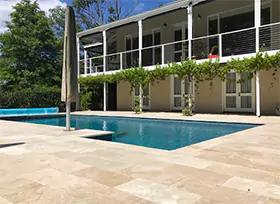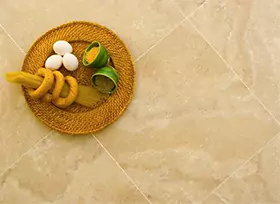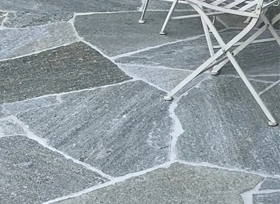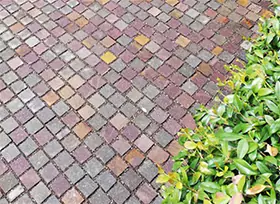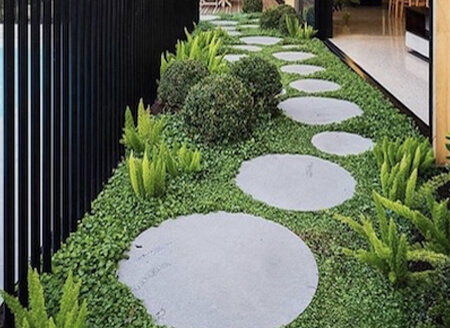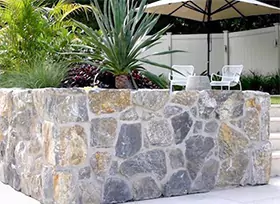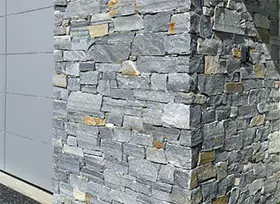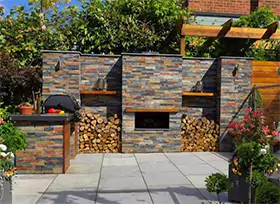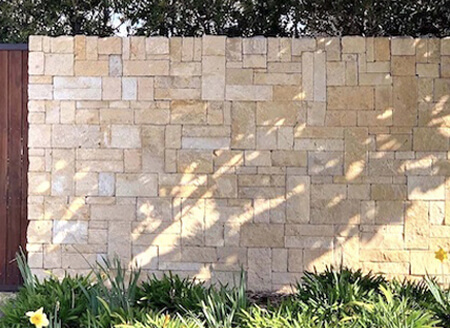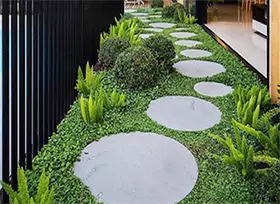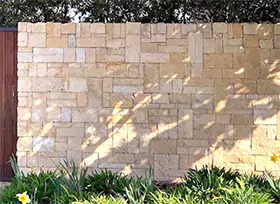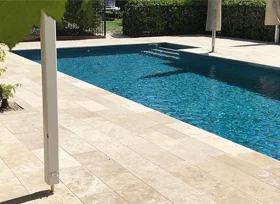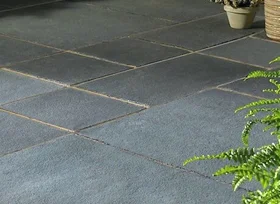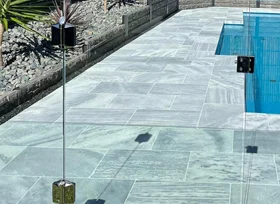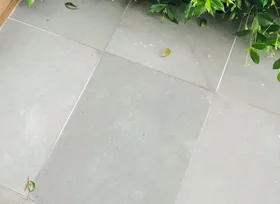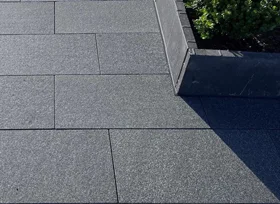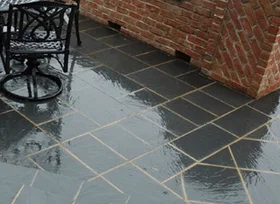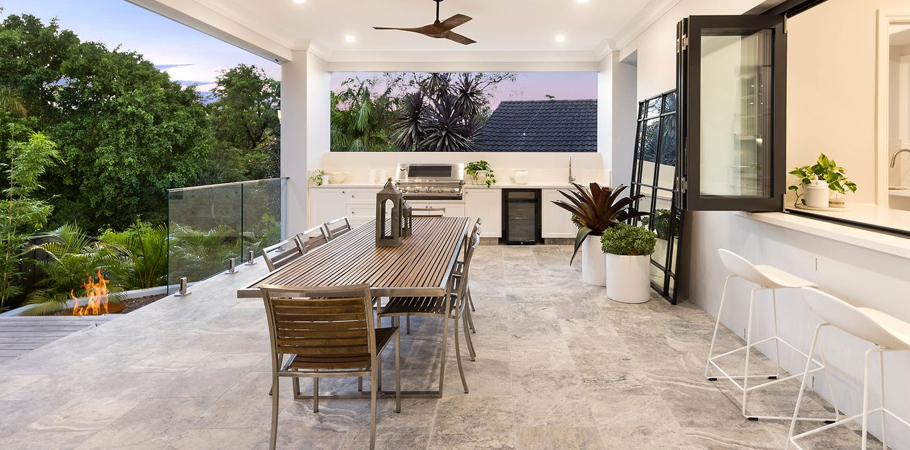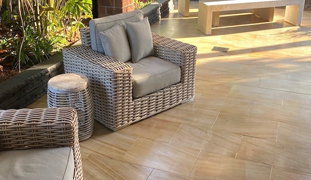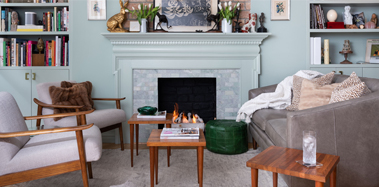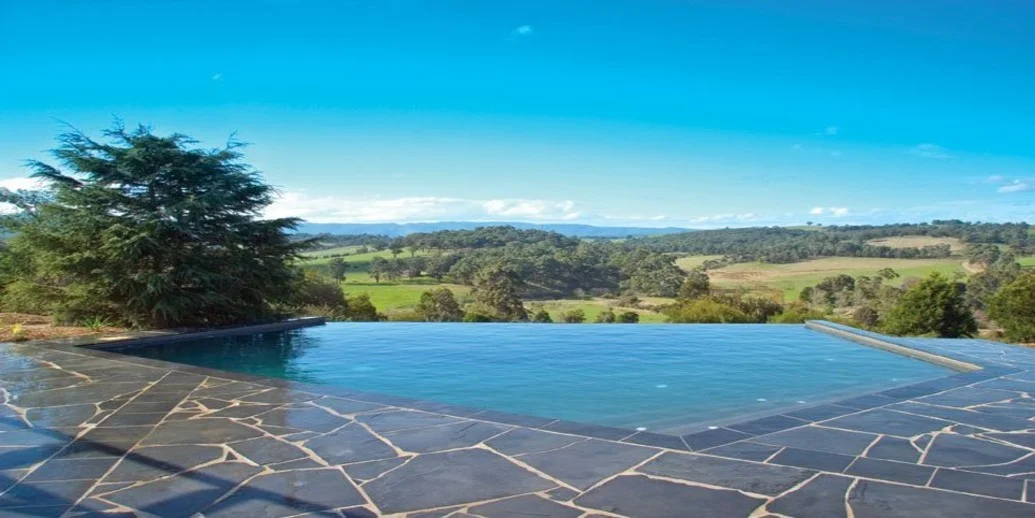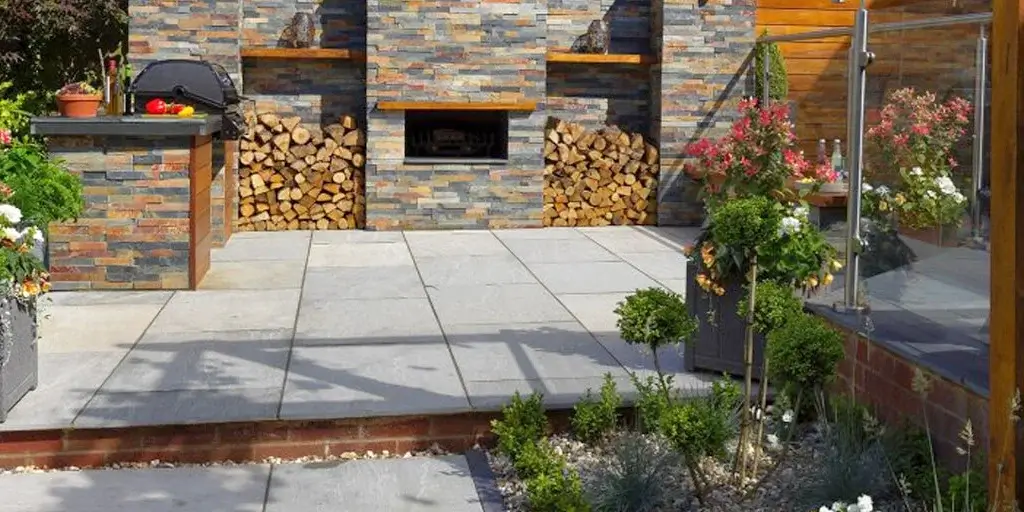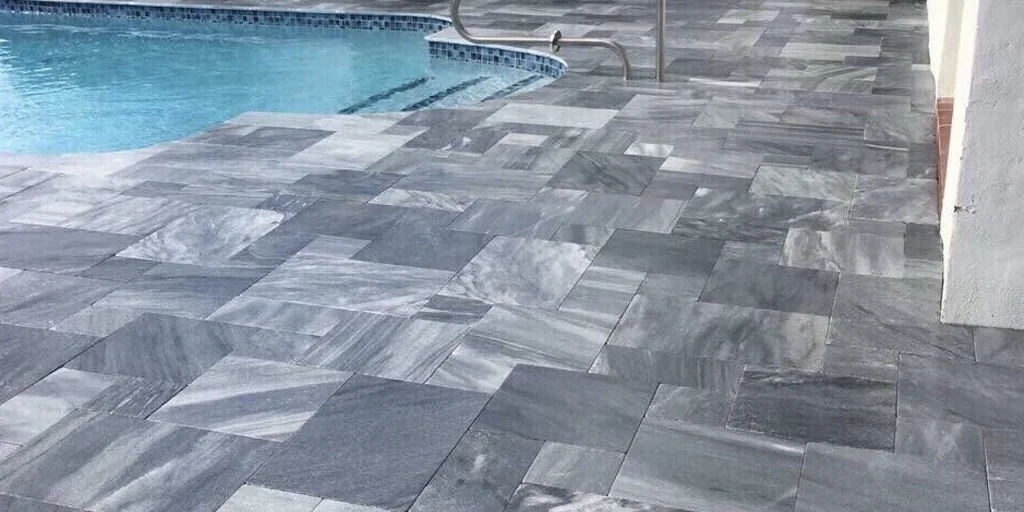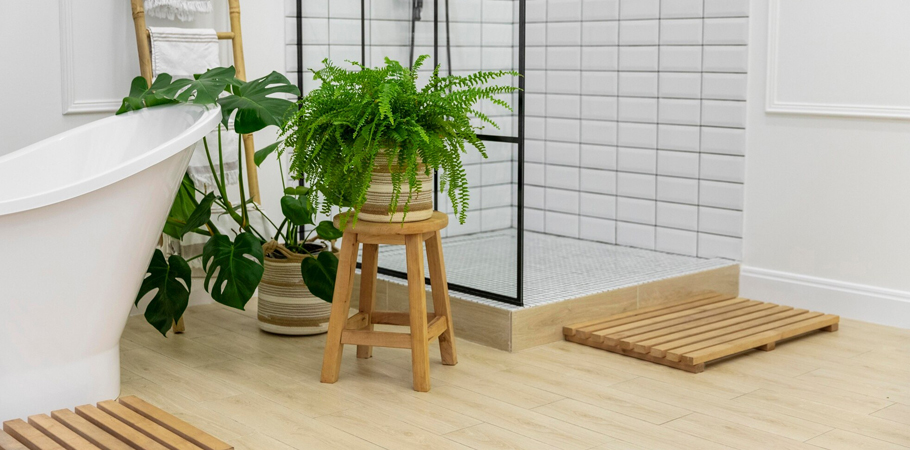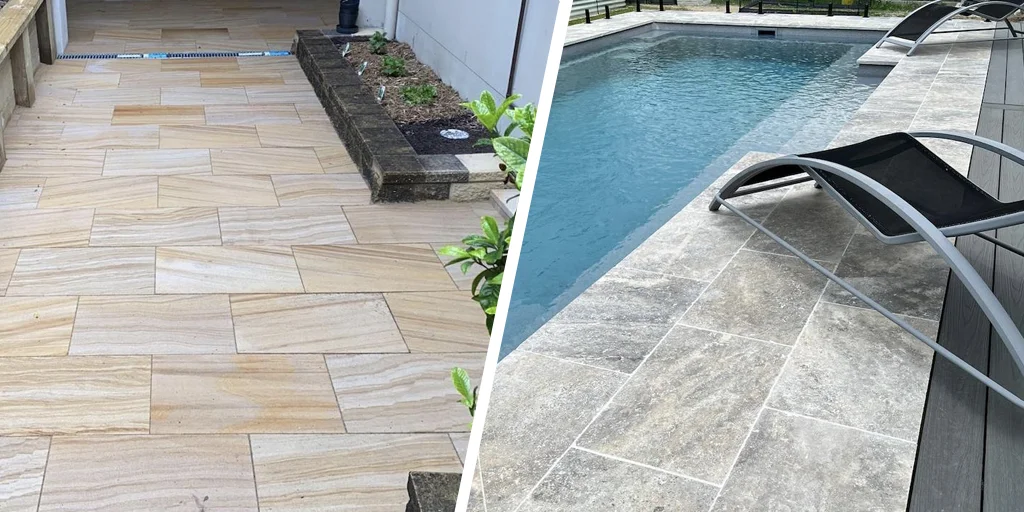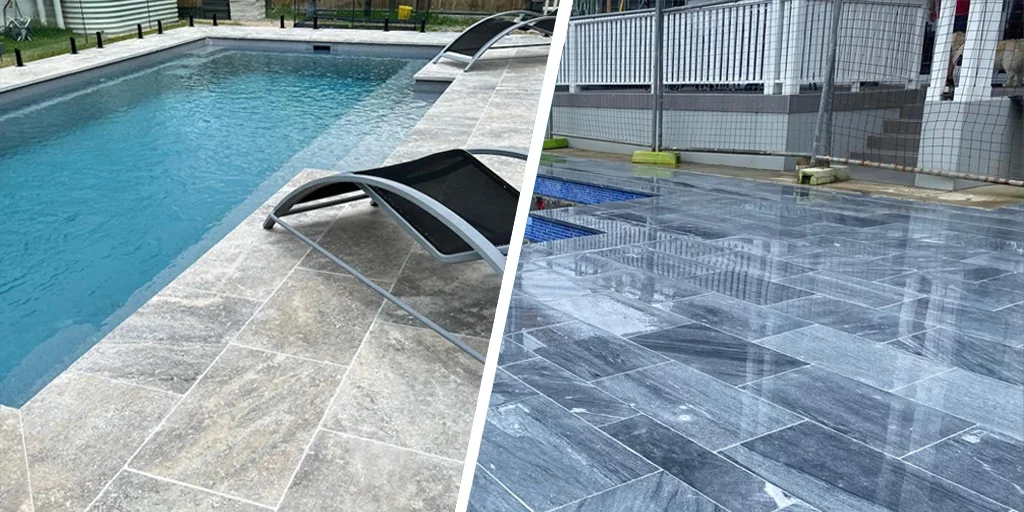Our Travertine stone is the only natural stone tile you’ll need for your upcoming home renovation project. This natural stone can enhance any indoor or outdoor setting with its durability and adaptability when maintained and cared for properly. It has a variety of hues, ranging from muted whites to intensely vivid reds. Here’s everything you need to know to determine if Travertine is the best natural stone feature for your house, whether you’re thinking about using it for countertops, wall cladding or flooring.
What Is Travertine?
Travertine is one of a kind of Limestone that hot springs gradually bring up to the surface. It may originate from a number of places. Some originate from distant places like Iceland and Indonesia, while others are closer to home, like Yellowstone National Park and the Grand Canyon. Travertine has a naturally pitted look because of tiny pores and craters created by erosion from the spring water.
During the production process, the pores can be filled or left as they are; during installation, fillers can be used. We usually offer unfilled Travertine to give a natural rustic look. Originally intended as an outdoor garden tile or pool paving material, its raw, weathered style is now a great option for inside flooring, backsplashes, shower walls and worktops. However, because of its porous nature, it is extremely susceptible to stains and acid damage. Its attractiveness has to be maintained with regular care.
What Types of Travertine Do We Have at Stone Depot?
Stone Depot brings an array of Travertine stones in the following forms:
- Tiles- When we talk about tiles, they are basically the ones that are used for indoor flooring or walling. They have a thickness of 12mm. Some of the tile measurements that we offer are 406x406x12mm, 610x406x12mm, 610x610x12mm and French Pattern 12mm.
- Pavers- Travertine pavers are mostly the ones that are used for outdoor space. The thickness is higher than that of tiles. It ranges from 30mm to above. Some of the paver’s measurements that we offer are 406x406x30mm, 610x406x30mm and French Pattern 30mm.
- Pool coping- Next on our list of offerings comes pool coping that is used for the edge of any pool area. Here are the ones that we offer 610x406x30mm Bullnose, 610x406x40/20mm Drop Edge and 610x406x70/30mm Drop Edge.
- Treads- We also offer treads in two distinctive sizes 1220x406x30mm Bullnose, 1220x406x30mm Pencil Edge. You can choose among them or customise them according to your needs.
- Risers- Last but not least are risers. We have just one particular sizing for the same, 1220x170x20mm.
All of these forms can be customised according to your design needs. You can set a call with our sales specialists about this.
Our Range of Travertine tiles and pavers
- Silver Travertine
- Classic Travertine
- Classic Light Travertine
- Classic Travertine (Honed)
Our premium selection of Silver Travertine tiles and pavers is ideal for enhancing your interior design with a dash of sophistication and individuality. Crafted from high quality natural stone that is mined in Turkey, these tiles and pavers have a stunning grey hue with hints of cream and beige. Silver Travertine’s exquisite colour combination can quickly makeover any area, including your floor, shower, kitchen backsplash, bathroom walls, mantle or fireplace.
In addition to being aesthetically pleasing, our Silver Travertine collections are strong and long-lasting. They may be used in both residential and commercial settings because they are made to resist normal wear and tear. The organic variances in the stone give your area personality and depth, giving it a genuinely unique appearance. Silver Travertine may be used in both classic and modern settings and its versatility allows it to blend in with any style.
Presenting our assortment of premium Classic Travertine, which is imported straight from Turkey, a country well-known for its excellent natural stone. These gorgeous pavers and tiles are ideal for giving any interior or outdoor space a dash of refinement and cosiness. Our Classic Travertine’s subtle variations in cream and beige tones provide a calming and welcoming ambiance.
Our Classic Travertine products are the perfect option whether you’re trying to improve your floors, showers, kitchen backsplashes, bathroom walls, ornamental walls or even your fireplace. The natural variations in the stone give your space character and depth, creating a really one-of-a-kind look. You can discover the classic elegance and resilience of Classic Travertine and turn your area into an opulent retreat.
Classic Light Travertine is a natural masterpiece that enriches your environment and defies trends. Embrace timeless sophistication with it. Take in the soft, earthy hues that define this magnificent stone, which strikes the ideal mix of timeless allure and adaptable grace.
Often used for walls, floors, and bathrooms, and available in slab or tile form, this material is linked to Mediterranean luxury and a lifestyle in Southern Europe. Not to mention its modest patterns that provide warmth, Classic Light Travertine tiles and pavers are a tried-and-true option.
An excellent quality Travertine with variations in beige and creamy tones that give this lovely stone its own character. A cement-based epoxy is used to plug the surface’s tiny pores, and the area is then machined down to a matt, smooth surface. Appropriate for interior residential homes.
Benefit of using Travertine
- Durability and Longevity
- Aesthetics and Versatility
- Heat Resistance
- Slip Resistance
- Easy Maintenance
- Eco-Friendly and Sustainable
There are many Travertine pros and cons but being a durable stone is what makes it a wise option for projects that involve both indoor and outdoor areas. Because of the gradual deposition of minerals, its solid, compact structure is resistant to weather extremes, intensive foot traffic and ageing. Travertine adds long-term value to any construction and, with careful care, may retain its original beauty for decades.
The inherent beauty of Travertine is one of its greatest benefits. The stone has a unique pattern with delicate veining and muted earth tones that gives it a refined and beautiful appearance. Travertine may be utilised as wall cladding, floors, worktops or ornamental elements to give any area a touch of classic elegance. It also comes in a variety of finishes, including tumbled, brushed, polished and honed, giving it adaptability to fit different tastes and design aesthetics.
Because of its superior heat resistance, Travertine is a great material for spaces that get a lot of heat, such outdoor patios, pool decks and fireplaces. Travertine, in contrast to synthetic materials, is cool to the touch even in the intense sun, making it a pleasant surface for relaxing or strolling on.
When it comes to safety in any construction job, Travertine is an excellent option. Its rough texture provides excellent slide resistance, especially when it’s left unpolished. Because slip incidents are more likely in damp locations like bathrooms, showers, and poolside areas, this makes it the perfect option for flooring applications in these areas.
To maintain its brilliance, Travertine needs just minimal upkeep. Typically, keeping the surface clean just requires periodic cleaning with a pH-neutral stone cleanser and routine brushing or vacuuming to remove debris. Travertine also resists stains and scratches, which lessens the need for replacements or repairs.
Because it is a natural stone, Travertine is a sustainable option for construction materials. When compared to synthetic alternatives, the production method of this renewable resource is relatively modest in terms of environmental effect and is gathered sustainably. In addition to promoting sustainability, using Travertine in construction projects helps lower carbon emissions.
Where can we use Travertine?
Bathroom Walls
Our Travertine can be used for any outdoor or interior surface, including walls. It is a natural stone that may be used as a backsplash or to tile your shower area. It is ideal for use in a bathroom because we offer various Travertine tile colours, from neutral tones to darker shades and simplicity of installation. Make sure you select filled and honed Classic Travertine tiles if you’re using them in a damp place since they have fewer natural pores that let water seep through. To help give the impression of space in a small area bathroom, it’s a good option to use large wall tiles. You can ask for customisation for the same.
Pool Decks
Travertine around the pool might be an amazing option if your backyard has a pool. The pavers are not only non-slip on hot days, which is helpful in this large splash area, but they also retain their coolness, protecting bare feet from burns.
Courtyards And Patios
We have Travertine pavers that are a striking option that will wow your guests, whether you have a patio at the rear of your house or a courtyard in the back of a hotel. It’s elegant, goes well with many different exteriors and has a wide range of pattern options for the arrangement.
Pool Coping
By adding our Travertine pool coping tiles to the edge of your pool, you can create a smooth, non-slip surface that will make your pool seem like a spa.
Stairs
We have a Travertine selection that is a great material for staircases because of its strength and resistance to wear. Because of its easy installation and adaptability, Stone Depot’s Travertine is a popular choice for staircases. Its tumbled and water-resistant surface also makes it a great material for pool edging and step treads.
Driveways
Concrete driveways are boring, but our Travertine paver selection might be the one you’re looking for. These stones make your home stand out from the neighbourhood. It enhances your house’s curb appeal and is resilient enough to withstand heavy footfall, harsh sunlight or heavy rainfall.
Walkways & Pathways
These natural stone pavers may add a lot of aesthetic appeal to a walkway that leads to your front door or a meandering path that shows guests around your garden. The nice thing is that you can install them yourself with ease using either a wet or dry setting.
Fireplace
Our Travertine stone will give your fireplace a more organic look and enhance the beauty and cosiness of any mantle or hearth. Additionally, we offer premium Travertine, a safer material to use near fireplaces because of its relative heat resistance.
Flooring
Travertine is a common flooring material that is offered in tile form and is available in a range of earth-tone colours, such as tans, browns, rust and beige tones. Although our Travertine is simpler to maintain than some other natural stone varieties, it is still a highly durable stone, and because of its porous nature, you must periodically seal the surface. It is not suitable in every setting. However, an interior space may benefit from the distinct combination of mountain-born beauty that a well-installed and maintained Travertine floor can bring.
Factors To Keep in Mind While Using Travertine
- Quality and Grade:
- Finish and Texture:
- Suitability for Outdoor Use:
Give top-notch stones first priority to ensure that your Travertine pavers have a polished and tasteful appearance. If you want your pavers to seem cleaner and more expensive, choose ones with minimal defects. Consistent colour variations among the pavers enhance the overall visual attractiveness of your flooring by creating the illusion of constancy. Because they are not only incredibly durable but also have a stunning appearance, Travertine pavers are an investment that will last for years to come. For these reasons, we only offer premium grades since they are much better than the commercial and standard grades.
The texture and polish of your Travertine pavers greatly affect their look as well as their safety. The worn, uneven surface of tumbled pavers makes it a fantastic choice for pool decks and other wet places because it prevents slippage. On the other hand, patio spaces and outdoor dining sets look great when they have brushed or honed surfaces because of their polished, smooth appearance. Select a finish that is appropriate for the area’s usage and foot traffic while also meeting your demands for visual appeal and slip resistance. We have both types of finishes available. Rest assured, you can also get on a call to have customised products delivered to your home.
Verify that the Travertine pavers you select are designed specifically for outdoor use. Particularly made for outdoor use, Travertine is resistant to moisture, UV rays, and temperature fluctuations. Because these pavers are resistant to fading, weathering, and disintegration, your outdoor flooring will remain vibrant and gorgeous for many years without losing its charm and beauty.
Maintenance Tips for Travertine
Like any other flooring or countertop material, Travertine maintenance is of utmost important. Schedule regular cleanings using a gentle cloth dipped in soapy water or use a broom to clear away any dirt. To guarantee that you don’t expose your stone surface to anything that might etch or discolour it, use a cleaner made especially for stone surfaces when wiping or mopping it. In terms of long-term care, apply a stone sealer to Travertine on a regular basis and make sure to fix any chips or cracks right away. Let’s know more in details:
- Regular Cleaning: Regular cleaning of Travertine is a must to keep the stones looking beautiful and aesthetic. You can simply sweep the flooring or use a microfibre cloth to clean the stones.
- Employ a Gentle Cleaning Agent: To clean your Travertine, use a pH-neutral stone cleanser or a solution of warm water mixed with a few drops of dish soap. Steer clear of abrasive or acidic cleansers as they may harm the sealant.
- Steer Clear of Harsh cleaning: Light cleaning with a towel or soft brush works just fine. Refrain from using scrubbers or pads with abrasives that might scratch the surface
- Rinse Well: To get rid of any residue, make sure you rinse the Travertine flooring well with clean water after everything is done.
- Preventive Measures: To prevent foot traffic from bringing in soil components that might harm Travertine pavers and tiles, always use carpet runners or doormats.
- Sealing: We recommend sealing all your natural stones before installation. Along with outdoor, indoor Travertine sealing is also a must to keep the organic look of the stones intact and avoid discolouration. We will know more about it in the next section.
Travertine Installation- Step-by-Step process
- Prepare And Level the Soil
- Create A Base for The Pavers to Rest On
- Lay Travertine Tiles or Pavers
- Cut The Pavers and Fill in The Joints
Making sure the ground is level where the pavers will be installed is the first step. After clearing away big boulders and other debris with a rake, use the straight edge to level the ground.
Once the dirt is level, use a plate compactor or tamper to compact it until it is flat. You are strongly advised to hire a plate compactor. On the other hand, here’s a cheap trick: saturate the soil with water, then compress it with a big wooden board. Till the ground is firm, move back and forth across the board. Although it takes longer and isn’t as effective as utilising a plate compactor, this method may be used quickly
The question now is: How can Travertine pavers be installed outside properly? The pavers need to be supported and kept level, so the next step is to build a base for them.
As a brief aside, it’s a popular misperception that weeds cannot grow between pavers if plastic sheeting is placed on top of your base. This procedure is superfluous and may result in future drainage issues and paver movement. Rather, poison the grass and plants beneath your base in advance.
To make the paver foundation level, use sand or blue metal dust. Then, do these crucial actions: Whether you are using pavers for a driveway or a walkway, uniformly distribute the sand or blue metal dust at a depth of 125 millimetres or 80 millimetres. As you compact it, make sure it’s level and hard. If additional sand or blue metal is required, don’t be scared to add it.
You must mark the area where you will place the pavers with the string line after the base is solid and level. Mark the area’s boundaries using wooden pegs, then extend the string line between them. Making sure your pavers are level and erect when they are installed has a significant impact on the overall appearance of the project.
Select your paver or tile pattern next. Brick bond, herringbone, and 45 stretcher bonds are a few popular patterns. If you want the simplest and fastest solution, choose the brick bond pattern.
We advise going with an off-white cement hue. Your Travertine paver will get stained with black cement. Using a trowel, spread the cement onto your base in accordance with the directions on the package. Cover a sufficient space with cement so that you can place one or two pavers at a time. Aim for a cement depth of 25mm.
Lay the pavers according to your preferred pattern, starting at one corner. Before placing each paver, use cement to seal any holes on the bottom of the stone. To assist the pavers adhere to the cement, place each one firmly onto the surface and tap down with a wooden block or rubber mallet. Eliminate any leftover cement; this will come in handy for grouting later.
There can be pavers at the ends that need to be cut once all the pavers have been put. After wetting the pavers, trim them to size using your diamond-bladed saw. Always use earplugs and safety glasses!
Once every paver has been cut, clean up any stray dirt with a brush before grouting the seams. Select a hue that complements your Travertine pavers and blend it as instructed on the packaging. Using a trowel, scoop up some grout and apply it evenly over the joints, pushing down firmly
After filling every joint, remove any leftover grout with a moist sponge or cloth. Walk on your freshly laid Travertine pavers only after the grout has had a full day to dry.
Why is Travertine Sealing Important?
Here are some benefits of Travertine sealing:
- Stain resistance: Using a Travertine sealer keeps liquids from seeping into the stone and leaving behind long-lasting stains. It allows you more time to mop up spills before they cause surface damage.
- Moisture protection: Water damage may occur to Travertine, particularly in spaces like kitchens and bathrooms. By creating a barrier, sealing helps avoid problems like efflorescence and water absorption by keeping out moisture.
- Simple upkeep: Cleaning and maintaining sealed Travertine is less difficult. It’s easier to clean up spills and maintain the stone’s clean appearance since the sealed surface is smoother and less likely to retain dirt.
- Durability: The Travertine’s surface is strengthened by the sealing procedure, increasing its resistance to deterioration. It aids in preventing fading, etching and scratches brought on by UV exposure.
What is the Average Cost of Travertine Pavers and Tiles?
The average Travertine cost, be it for pavers or tiles, is measured in mm, that is, metre squared. It varies depending on the following aspects:
- Colour
- Thickness of the pavers or tiles
- Grade, i.e. is it Premium, Commercial or Standard
The prices per m2 doen't include additional supplies like grout and the appropriate glue.



